
© 2010-2025 by Fine Arts of the Southwest, Inc. All rights reserved.
Unauthorized reproduction or use is strictly prohibited by law.
An exceptionally elegant Navajo Arts and Crafts Guild silver cuff bracelet set with a large high-grade Nevada turquoise stone, c. 1940’s
This is precisely the kind of knock-down, drag-out eye-poppingly gorgeous Modernist-style jewlery piece the Navajo
Arts and Crafts Guild (NACG) was famous for. They could hit the ball out of the park whenever they wanted by virtue
of their elegant streamlined design sensibility and their equally remarkable technical proficiency and execution.
The Guild’s silversmiths were an outstanding all-star team of the finest Navajo and occasionally Pueblo silversmiths anywhere from luminaries like Guild Co-Founders, Ambrose Roanhorse and Chester Yellowhair to Kenneth Begay, the three Kee brothers, Allan, George and Ivan to part-time contributors such as Charlie Bitsui, Austin Wilson and Jack Adakai. The Navajo Guild was a high quality professional operation and it deserved and enjoyed considerable prestige. One of its earliest Directors was the great Navajo and Pueblo jewelry authority and distinguished anthropologist and author, John Adair, and the Guild's jewelry was considered to be of such high quality that it was purchased and sold by such high-end American retailers as Tiffany and Company of New York and Marshall Field and Company of Chicago.
If we were betting people, our money would be on either the great Ambrose Roanhorse or even more likely, the superbly talented Kenneth Begay as being the maker of this outstanding bracelet, so refined and streamlined is the artistic sensibility and so awesome and precious is the craftsmanship, but we will never really know as Navajo Guild regulations strictly forbid any personal artist signatures on Guild pieces, only the NACG’s famous Horned Moon hallmark could be used. To learn more about the Navajo Arts and Crafts Guild, please click here.
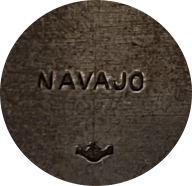
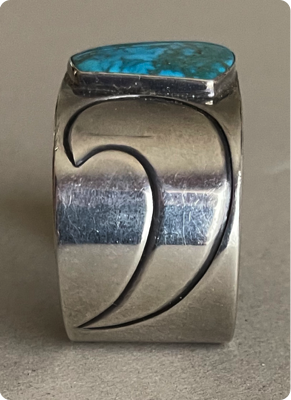

The design and fabrication of this piece are extraordinary and in keeping with the Guild’s general aesthetic design guidelines; large expanses of silver, minimal applied stamp work or chisel decoration and limited use of set stones.
There are only three design elements here; an absolutely gorgeous large central trapezoidally-shaped turquoise stone from either Nevada’s Lone Mountain or Blue Gem mine and two outstanding pieces of chisel work on either side in lovely curved arabesque lozenge shapes surrounding and perfectly accentuating the stone; it just couldn’t be simpler, just couldn’t be more beautiful! And ironically, it just couldn't be more excruciatingly difficult to make it all look so completely effortless and precious.
And now a few more words about the bracelet's large, beautiful hand-cut trapezoidally-shaped Nevada turquoise stone. The large stone measures approximately 1 1/8" in width and 1 1/8" in height at its largest points. We are not completely certain of the mine origin of this gorgeous high-grade stone, but to our eye, this stone has some distinct elements of Nevada's fame Lone Mountain mine, notably the deep saturated blue-green color and the wispy tendrils of brownish-grey matrix inside the stone. It also has some elements of another famed Nevada turquoise type which is Blue Gem in its color and somewhat similar, although less wispy-looking brown matrix. A comparison of stones from these two mines can be seen below, but you cannot go wrong in either case here. This is a particularly beautiful gem quality stone.
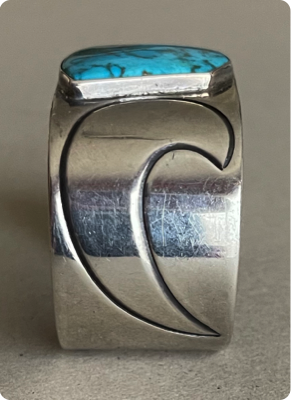
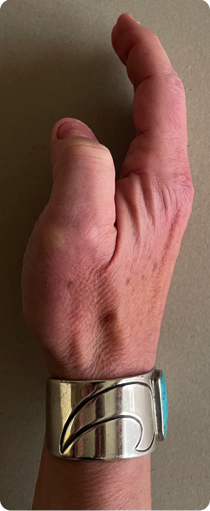
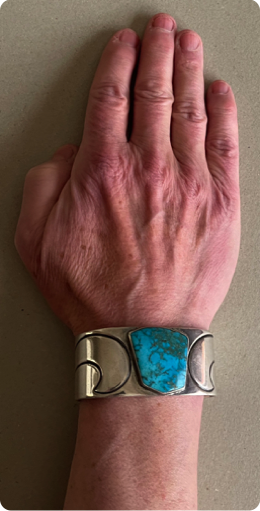
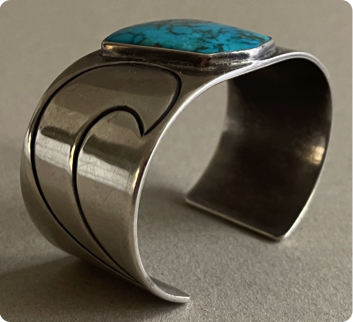


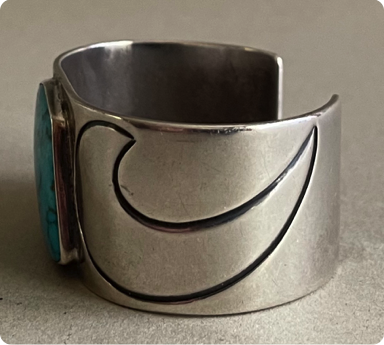

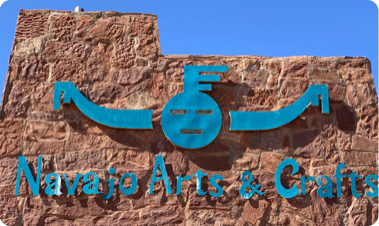
The Navajo Arts and Crafts Guild is still in operation today. Here is its outlet in Cameron, Arizona.
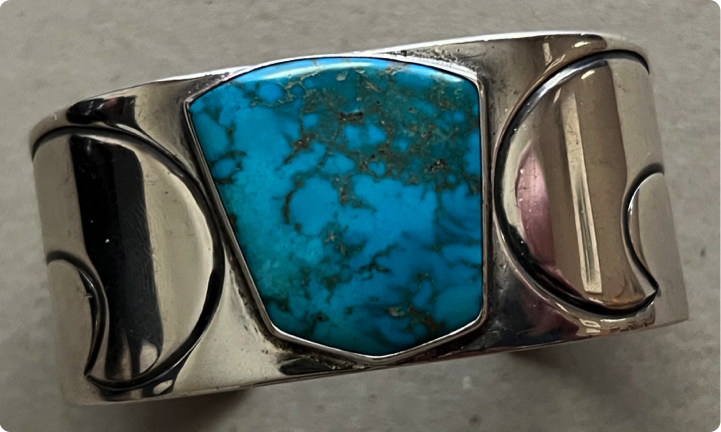
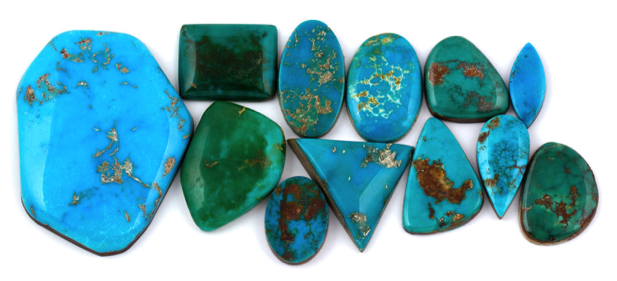

Lone Mountain Turquoise
This mine once produced a great variety of turquoise, included some of the finest examples of spider web turquoise as well as clear, deep-blue stones. Lone Mountain turquoise has always been noted for holding its color. Among all “classic” Southwestern turquoise, only Lander Blue is more valuable. A rare occurrence has been the “fossil turquoise” found in this mine. The fossil is of a crinoid stem. The Lone Mountain mine consists of a series of haphazard tunnels dug by miners chasing the veins of turquoise. The mine was claimed by Lee Hand in 1920 first as the Blue Jay Mining Lode and later, after seeing that so many mines had been named Blue Jay, Hand changed the mine’s name to Lone Mountain. In the 1960’s Lone Mountain was converted to a small open pit operations by Menliss Winfield. It continues to be mined in this fashion today. In 1979, I purchased Lone Mountain with the King family of Austin, Texas and Santa Fe, New Mexico. I have had different partners over the years and the property has only been mined 6 over the last 28 years. The reason for this is the expense of mining and the regulations for small mine owners, makes it very difficult to be profitable. But with the value of the classic American turquoise mines being so great, it is feasible for this great mine to once again be of great value.
Blue Gem Turquoise
This mine, which is no longer active was located about six miles south of Battle Mountain, within a large copper-mining operation. Of the several Nevada mines that are named Blue Gem, this is the largest and most famous. It produced a great variety of turquoise from intense blue to deep green combinations with a hard, irregularly distributed matrix. Blue Gem’s hardness and fine colors makes this turquoise much sought after by both jewelers and collectors.
-Lone Mountain and Blue Gem turquoise photos and text source and © Waddell Gallery, Scottsdale, AZ
The bracelet silver shank measures 1 1/8" in continuous width all the way around. The inner circumference end-to-end is 5 3/4" and the gap between the terminals is 1 3/16" for a total interior circumference of 6 15/16". The bracelet weighs
a satisfying but very comfortable 80 grams or 2 3/4 ounces and it is in thoroughly excellent original vintage condition and particularly so for its almost eighty or so years of age. There are a few small dings and scratches here and there, but overall it's in remarkably good shape with a beautiful almost glowing patina. The bracelet is properly signed on the interior with The Navajo Guild’s famous "Horned Moon" hallmark and the capital letters word "NAVAJO".
This bracelet is a thing of great beauty and meaning; it's a wonderful piece of precious wearable jewelry, yes first
and foremost, but it is also a piece of proud culture and art born of a specific time in a specific place with a specific creative artistic tradition and direction. It’s a lot of weight for a decorative object to carry, and this bracelet does
it beautifully and absolutely effortlessly. It would be a true joy to own, wear and deeply admire.
Price $4,950